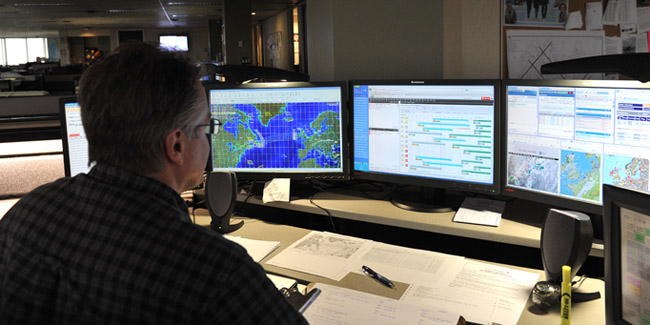The aviation world is a symphony of precision and coordination, where every aspect seamlessly comes together to ensure passengers reach their destinations safely and efficiently. While the glamour of flying captures our attention, there’s a complex and intricate web of operations working behind the scenes. Welcome to the heart of the matter — an in-depth exploration of how airlines manage flight operations to keep the skies safe and journeys smooth.
Setting the Stage: The Dance of Flight Operations
Picture this: A passenger settles into their seat, eagerly awaiting takeoff. But before the aircraft ever leaves the ground, a meticulously choreographed dance of flight operations unfolds. From planning routes and scheduling crews to ensuring aircraft are airworthy, multiple departments collaborate seamlessly to make this aerial performance possible.
The Blueprint: Flight Planning and Dispatch
At the heart of every successful flight lies a well-crafted flight plan. This blueprint outlines the entire journey — from departure to arrival — detailing the route, altitude, fuel requirements, and alternate airports in case of unforeseen circumstances. Flight dispatchers, often stationed in airline operations centers, use cutting-edge software to create these plans while considering factors like weather conditions, air traffic, and fuel efficiency.
Piece by Piece: Aircraft Maintenance and Inspection
Imagine a puzzle. Now, envision an aircraft as that puzzle, with each piece representing a crucial component. Aircraft maintenance technicians ensure every piece is in place and functioning flawlessly. Regular inspections, ranging from routine checks to comprehensive overhauls, are carried out to guarantee the aircraft’s airworthiness. This meticulous attention to detail helps prevent in-flight issues and ensures passenger safety.
Captain of the Ship: The Role of the Pilot
Pilots are the face of flight operations, but their responsibilities extend far beyond the cockpit. They work in tandem with dispatchers, reviewing flight plans, weather reports, and navigation charts before takeoff. During the flight, pilots manage communication with air traffic control, make real-time decisions based on changing conditions, and prioritize passenger safety and comfort. Their expertise is the linchpin of every successful flight.
Around the Clock: Crew Scheduling and Management
Behind the scenes, a dedicated team manages crew scheduling, a task akin to solving a complex puzzle. From pilots and co-pilots to flight attendants, each crew member’s availability, rest periods, and specific qualifications are considered. This ensures that the right crew is on board for each flight, adhering to strict regulations that prevent fatigue and maximize performance.
Navigating Complexity: Air Traffic Control
As aircraft take to the skies, they enter a meticulously controlled airspace guided by air traffic control (ATC). ATC towers, en-route centers, and radar systems work in harmony to manage the flow of traffic, ensuring safe distances between aircraft and directing them along their planned routes. The collaboration between pilots and ATC is a dynamic dialogue that guarantees smooth navigation even in the busiest of skies.
Behind the Screens: Technology and Digital Transformation
The digital age has revolutionized flight operations. Advanced technologies like Electronic Flight Bags (EFBs) have replaced traditional paper charts, giving pilots instant access to vital information. Big Data analytics aid in predictive maintenance, identifying potential issues before they disrupt flights. And as the world embraces automation, aircraft are equipped with systems that can autonomously manage certain aspects of flight.
Constant Vigilance: Safety First
Above all, safety is the driving force behind every flight operation. Airlines adhere to rigorous safety protocols set by aviation authorities, employing Safety Management Systems (SMS) to identify and mitigate potential risks. Incident reporting and analysis enable continuous improvement, ensuring that every flight operation becomes safer than the last.
Global Jigsaw: The International Dimension
Flight operations extend beyond borders, making international cooperation essential. Airspace agreements, known as “Open Skies” agreements, facilitate international flights by removing regulatory hurdles. This collaboration allows airlines to seamlessly operate across multiple countries, expanding travel options and connecting cultures.
Weathering the Storm: Challenges in Flight Operations
Behind the scenes, flight operations face their share of challenges. Unpredictable weather, air traffic congestion, and unforeseen technical issues can disrupt even the most meticulously planned journeys. Additionally, the aviation industry is ever-evolving, with changes in regulations and technologies demanding constant adaptation.
Into the Future: Innovations in Flight Operations
As technology continues to advance, the future of flight operations holds exciting possibilities. Artificial intelligence and machine learning could enhance predictive maintenance, reducing downtime and improving efficiency. Electric and hybrid aircraft promise more sustainable aviation, while advancements in air traffic management could lead to more precise routing and reduced congestion.
The Grand Finale: A Synchronized Symphony
In conclusion, while passengers may only experience a fraction of the efforts involved in flight operations, the behind-the-scenes orchestration is nothing short of a synchronized symphony. From flight planning and aircraft maintenance to pilot expertise and air traffic control, every element harmonizes to create the seamless journeys we often take for granted. The next time you buckle up for takeoff, remember the intricate dance happening behind the scenes, ensuring that your flight is a safe and unforgettable experience.
























